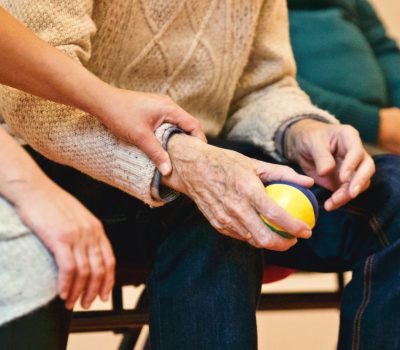Spasticity is a medical term for the way in which your muscles behave after an injury to your neurological system – this could be your brain, spinal cord or the nerves that run throughout your body.
Normally your muscles have the ability to turn on, turn off and to grade the speed of their movement through lots of complex systems. Think of your body like a computer (except more complicated), you have sensors in your muscles, skin and throughout most of the structures in your body, for example your eyes are sensory organs and provide a lot of information. By working together these sensors send information to your brain, and receive information back again, in this instance your muscles provide lots of information on where your body is, how it’s moving and feeling.
When your neurological system is injured or you are diagnosed with a neurological condition your muscles can change the way they behave. They may lose their ability to turn on, turn off or grade movements effectively. This could be due to slow or altered messages coming from the muscles to the brain, or difficulty processing and sending out messages from the brain to the muscles. Regardless of the cause, what you may end up with are muscles in certain parts of your body that are “on” a lot of the time, causing them to become tight over time.
Spasticity is often described as an altered response to stretch, where the information either sent or received may interpret the movement as a stretch and cause the muscle to contract. It is often dependent on the speed of movement, with faster movements causing a stronger resistance and contraction.
A side note on “clonus” – clonus is a specific term used to describe spasticity, often in the calf complex and can be characterised by a “bouncing” of the muscle when it is placed on a stretch.
In what conditions will spasticity occur?
We talked briefly above about some of the mechanisms within your body, namely the sending and receiving of information to and from the brain via the muscles and sensory organs and how this may change in certain conditions. The list below is by no means exhaustive but we aim to provide a small insight into some of the more common causes of spasticity.
Stroke & Brain injury – Both of these conditions result in injury to the brain, think of it like the processor of a computer, most of the information passes through here before it is sent back out. When you sustain an injury to the brain in certain areas it can cause the muscles in your affected side to present with spasticity as your brain is unable to send messages to the affected arm or leg and may or may not be able to correctly interpret the information coming back to it. Please see our article “What is a Stroke” for more information around this condition (link).
Multiple Sclerosis (MS) – When diagnosed with MS you may hear the term “lesions” or “plaques” used, these terms describe areas in your nerves where there may be an interruption in signal either to or from the brain. These lesions serve to slow down the transmission of the signal and can affect things like coordination and strength of the muscles. Over time you may find these muscles begin to present with spasticity, this is due to the altered signals going to and from the brain and muscles.
Cerebral Palsy (CP) – Cerebral palsy is a condition you are born with and represents an injury to the brain before, during or after birth. Everyone with CP is different and some may have spasticity and some may not, however it is quite common to have some effect on your muscles. Because CP is a lifelong condition you will have grown up with your body working differently, you may find your body harder to move and difficult to coordinate due to increased tone in your muscles.
Spinal Cord Injury (SCI) – Your spinal cord is responsible for transmission of information from the rest of your body to and then back from the brain, as well as some automatic elements of movement and bodily functions. If you sustain a Spinal Cord injury, typically the muscles below the level of injury are affected, this can depend greatly on the type of injury sustained. As a result these messages are interrupted and spasticity in your muscles can occur.
Is spasticity painful?
Having never experienced spasticity this is often a difficult question to answer, however working in neurology for the last 14 years I can answer that from experience it varies. Some people may experience pain in the form of a cramp like feeling if it is persistent, sometimes spasticity can be accompanied with pain (although it may not be the cause of the pain) and sometimes muscles get stiff and tight over time due to spasticity and this can be sore or painful. However lots of people we work with describe no pain, it really does depend on the condition we are working with and the extent of the spasticity.
What can I do about spasticity?
The good news here is that spasticity can be effectively managed through a number of interventions. Not all interventions are suitable and really you should seek guidance from a physiotherapist with specialism in neurology or your consultant. I have listed some of the more common interventions below (this list is by no means exhaustive):
Stretching – The most common recommendation is stretching. Here we are looking to normalise the range of movement in your affected limb but exposing your body to the positions that may cause the muscle to contract. It will also help to ensure your muscles do not get tight and lose movement over time. It is a really important part of managing your affected limb and we would encourage stretching to be part of your daily routine.
Splinting – Splints, some people like them, some people hate them! They aren’t for everyone and a correctly fitted splint is really important to ensure you don’t get sore. Current research suggests that splinting is really the gold standard for managing spasticity, ideally if these splints are worn for 4-6 hours daily. It is important that the splint is prescribed by your physiotherapist, occupational therapist or orthotist and then your tolerance to it is built up over time. Combining this with a stretching program gives you the best opportunity to manage and potentially improve your muscle tone.
Electrical Stimulation – There is some evidence that regular use of a muscle stimulator machine can help to manage spasticity. By attaching the electrodes to the opposite (often under active) muscle group you can provide a stretch whilst stimulating a contraction of the opposing group. This should be guided and set up by a physiotherapist as there are certain conditions that would not be safe to use this equipment.
Botulinum Toxin (Botox) – Not just for your face! Botox can be used as a way of switching the muscle off. It helps to stop the muscle receiving the incorrect information from the nerves by blocking the receptors of this information within the muscle. The benefit of Botox is that it’s localised to the muscle in question, rather than a medication you take which can affect other systems in your body.
It should be administered by an injection by a consultant or very specialist physiotherapist and explained thoroughly prior to this. Botox often will only last for 3 months and although you can have repeat injections there are often limits to how many times in one year you can receive it, so as not to form a resistance to it. Research suggests that Botox is most effective when combined with a stretching and splinting program and is not a stand alone treatment.
You can gain a referral for Botox assessment via your GP, consultant or physiotherapist, although this is no guarantee you will be suitable after an assessment.
Medication – Often you will also be offered medication to help manage your spasticity, there are numerous medications available the most common being:
- Pregabalin
- Baclofen
- Gabapentin
- Tizanidine
- Diazepam
- Clonazepam
- Dantrolene
All medications may have side effects and will not suit everyone, your trial of these medications should be prescribed ideally by your neurologist and overseen by your GP. If one is not working for you it may be worth swapping to another, often if you are taking other medications they can interact together so it’s important to find the best one for you.
What’s the difference between spasticity and tight muscles?
Spasticity is an altered response of your neurological system as we discussed above and can lead to tight muscles if not addressed. Tight muscles may present as a restricted range of movement but often the muscles will be acting more normally without the over activity present with spasticity. A physiotherapist or consultant will be able to tell you the difference if you are not sure.
Should I be worried about it?
If you are worried about a new onset of spasticity or something similar then I would recommend seeing your GP in the first instance as it can be an indication of a neurological problem, however this is not always the case.
If you already have spasticity then it isn’t necessarily something to worry about, but it is something you may need to manage and work on as over time it can lead to other problems such as permanent restriction of movement (contracture), changes in posture and discomfort from unmanaged spasticity. However we work with lots of people who effectively and consistently manage it and do not experience these other difficulties.
Who is best to speak to if I am concerned or want an opinion?
If you are experiencing spasticity or changes in your muscle tone and coordination then it is best to speak with your GP or a physiotherapist in the first instance. If you already have a neurologist they can also be a good starting point for a discussion on how to manage things.






